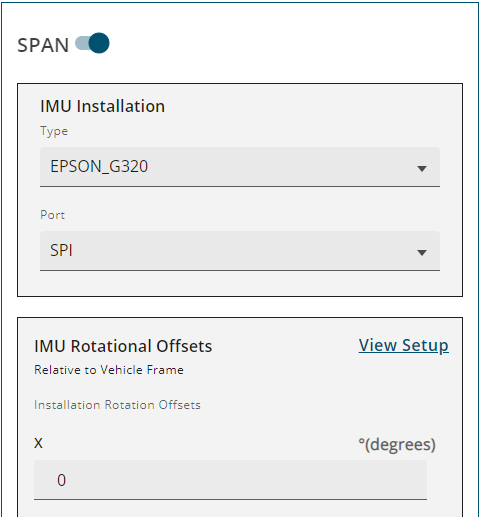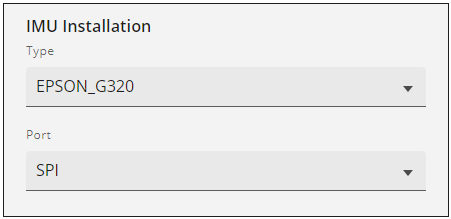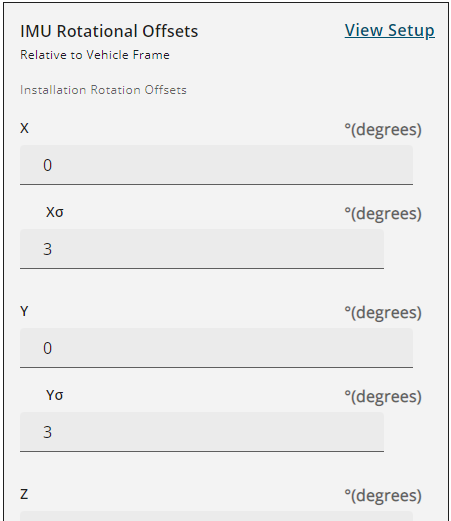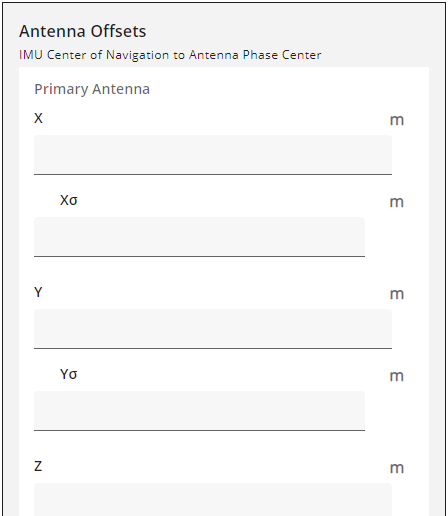SPAN Configuration

Use the SPAN configuration page to configure SPAN GNSS+INS technology on the receiver.
To use SPAN, the receiver must have an internal IMU (CPT7, CPT7700, PwrPak7-E1, PwrPak7D-E1, PwrPak7-E2, PwrPak7D-E2 or SMART7-S) or be connected to a SPAN compatible IMU.
A dual frequency capable GNSS antenna is required to use SPAN.
Click the SPAN bar to open the SPAN page.
SPAN
Use this switch to enable or disable SPAN.
IMU Installation

For receivers with an internal IMU (CPT7, CPT7700, PwrPak7-E1, PwrPak7D-E1, PwrPak7-E2, PwrPak7D-E2 or SMART7-S), do not change the IMU Type or Port. The correct IMU Type and Port are configured at the factory.
Type
Click the Type drop menu and click on the IMU connected to the receiver.
Port
Click the Port drop menu and click on the communication port to which the IMU is connected.
IMU Rotational Offsets

The Installation Rotational Offsets are the differences in orientation between the IMU Body Frame (typically marked on the IMU enclosure) and the vehicle frame. In the vehicle frame, Z is always considered to be upwards, Y is forward through the direction of travel, and X is to the right.
The order of rotations is Z-X-Y and all rotations are right handed.
In the X, Y and Z boxes, enter the rotations, in degrees, from the IMU Body Frame to the vehicle frame.
In the Xσ, Yσ and Zσ boxes, enter the rotation offset standard deviation. The standard deviation settings are optional.
Click View Setup to see a representation of the IMU rotation.
Antenna Offsets

Primary Antenna
The Primary Antenna offset is the three dimensional distance from the IMU to the GNSS antenna. The primary antenna offsets are required for all SPAN systems.
In the X, Y and Z boxes, enter the distance, in metres, from the IMU center of navigation to the GNSS antenna phase center. The offsets are measured in three directions, X axis, Y axis and Z axis, relative to the IMU Body frame.
In the Xσ, Yσ and Zσ boxes, enter the offset standard deviation in metres. The standard deviation settings are optional.
The measurements for the offsets should be done as accurately as possible, preferably to within millimetres especially for RTK operation. Any error in the offsets will translate into an error in the INS position.
Large standard deviations can lead to an inaccurate position solution. Therefore, it is highly recommended to measure translation offsets as accurately as possible and to manually enter translation offset standard deviations that reflect that accuracy.
Secondary Antenna
If the SPAN system has a second GNSS antenna, the secondary antenna offset parameters display.
In the X, Y and Z boxes, enter the distance, in metres, from the IMU center of navigation to the phase center of the secondary GNSS antenna. The offsets are measured in three directions, X axis, Y axis and Z axis, relative to the IMU Body frame.
In the Xσ, Yσ and Zσ boxes, enter the offset standard deviation in metres. The standard deviation settings are optional.
User
If the SPAN system has another device for which the relative location is needed by the SPAN system, set the User offset parameters.
In the X, Y and Z boxes, enter the distance, in metres, from the IMU center of navigation to the location of the device. The offsets are measured in three directions, X axis, Y axis and Z axis, relative to the IMU Body frame.
Click Apply to save the changes to the receiver.